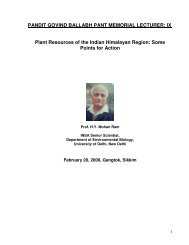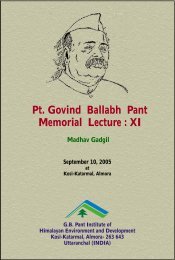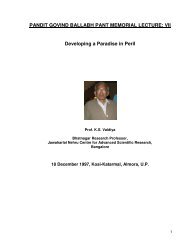Pandit Govind Ballabh Pant Memorial Lecture: II
Pandit Govind Ballabh Pant Memorial Lecture: II
Pandit Govind Ballabh Pant Memorial Lecture: II
You also want an ePaper? Increase the reach of your titles
YUMPU automatically turns print PDFs into web optimized ePapers that Google loves.
the southern edge of the Asian continental plate, resulted in the rise of Himalaya. The<br />
peninsular plate continues to move north about 8 cm per year resulting in continued<br />
rise of the Himalaya (Audley Charles et al, 1981). Continued northward movement of<br />
the peninsular plate gives this mountain system an inherent instability. It is, therefore,<br />
not unexpected that there have been series of devasting earthquakes, the last being on<br />
October 20, 1991 in the Uttarkashi- Tehri region of Garhwal (Valdiya, 1991).<br />
The tectonic breakup of Gondwanaland and subsequent drift and collision of<br />
peninsular plate at Assam, resulted in the creation and continuous rise of the<br />
Himalaya. This mountain system is the youngest, the tallest, and the most fragile<br />
mountain systems in the world. The erosion of the young Himalaya resulted in<br />
production of alluvia that led to filling and drying up of the Tethys Sea in the North-<br />
West India. With this, were born the Indus and the Gangetic alluvial plains. Other<br />
geological details have been discussed by Wadia (1975).<br />
From the times immemorial, Himalaya has attracted spiritual leaders, devotees,<br />
expeditionists, mountaineers, venture trekkers, tourists and scientists of all specialties.<br />
The mountain system has been a source of tremendous inspiration. There are many<br />
trusts, foundations, societies, in non-governmental sector in India and abroad which are<br />
concerned about Hiamalaya. This mountain system has also seen battles which have<br />
left their imprint: the well known among there is the Rupkund tragedy. The alpine<br />
Rupkund Lake (4850m altitude) is situated at the base of Trishul massif on the southern<br />
fringes of Nanda Devi Sanctury. The mystery deepened with the discovery of many<br />
human skeletons and even undecomposed human flesh buried under scree and bolders<br />
on the north western slopes. Considerable myth is woven round this.<br />
The Himalaya has been called variously: Abode of Snow, Abode of Gods,<br />
Weather –maker of the Indian Subcontinent, The Third Pole- a feature on earth no<br />
where else to be seen. The mountain system has inspired awe, respect and reverence.<br />
The Himalaya has been fountain head of yogic wisdom and spirituality of millions of<br />
Indians, not withstanding their differing religious beliefs. One only needs a mind, an<br />
eye and an ear to understand, see and hear the spiritual glory of Himalaya. Those of us<br />
who were born, bred up and educated in the company of the awe-inspiring mountain<br />
peaks have been told by their parents and other elders, the story of sages, religious<br />
leaders, artists, poets and philosophers who have been attracted from far and wide to<br />
this abode of snow. The mountain chain has influenced the life, culture and history of<br />
India.<br />
The clouds rise in the Indian ocean and the Bay of Bengal, and are trapped on<br />
south side of the Himalaya and shower their “blessings” in the form of monsoon year<br />
after year. The mountain system not only traps monsoon winds, but also obstructs the<br />
cold dry Tibetan and Siberian winds. The Himalaya is thus the guardian of the Indian<br />
subcontinent. However, the monsoon is a mixed blessing. The young Himalaya with<br />
very steep slopes and unconsolidated soil is indeed fragile. The situation is<br />
compounded by increased human & livestock population pressure and deforestation.<br />
The mountain system is thus prone to high rate of erosion which results in floods year<br />
after year bringing untold misery to the poor people both in the mountains and in the<br />
plains (see also Agarwal and Chak, 1991). On the other hand, monsoon also makes<br />
5











